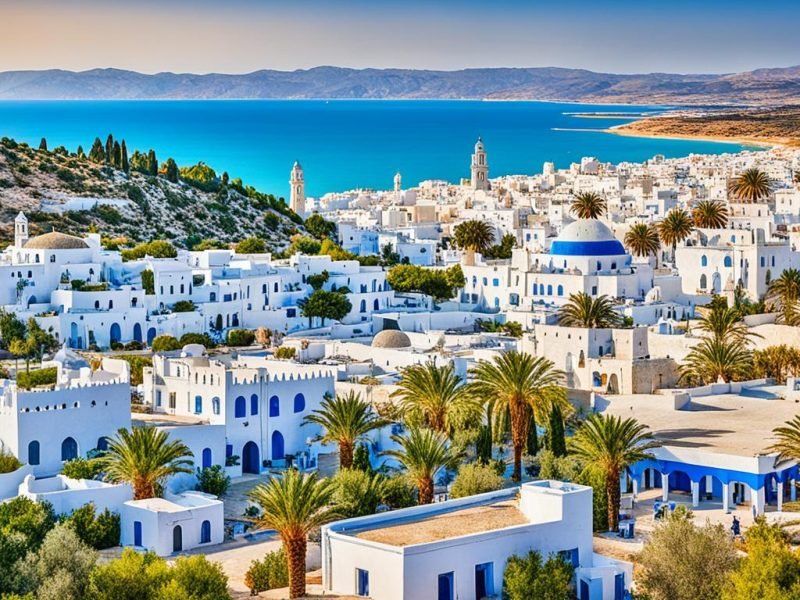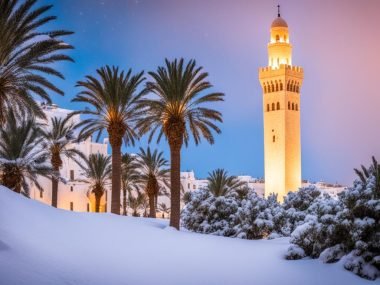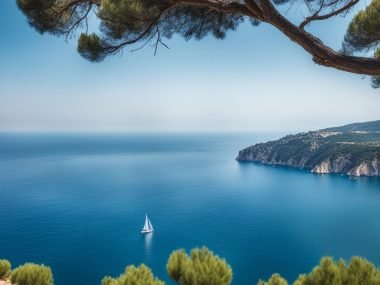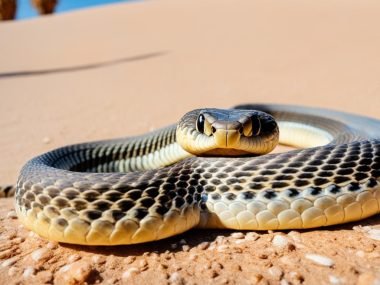Did you know Tunisia is the smallest country in North Africa? It is very important due to its location. It’s at the very top of Africa, making it a key point between Africa and Europe. Tunisia is next to Algeria and Libya. It also touches the Mediterranean Sea. This country has mountains and a big desert called the Sahara. Its culture is a mix of Arab and Berber traditions. The capital city, Tunis, shows off Tunisia’s history and modern side. People there speak Arabic and French. This is because of Tunisia’s past with different cultures.
Key Takeaways
- Tunisia is at Africa’s top, linking it with Europe.
- It is close to Algeria, Libya, and the Mediterranean Sea.
- The country has mountains and the Sahara Desert.
- Its culture comes from Arab and Berber influences.
- Tunis is where Tunisia’s past and present meet, with both Arabic and French spoken.
Introduction to Tunisia’s Geography
Tunisia is at the top of Africa, making it very special. It is known as the northernmost country in Africa. Its place in the world has made it full of history and culture.
Geographical Coordinates and Location
Located at 34°N 9°E, Tunisia connects Africa with Europe. It has a big coastline on the Mediterranean. This has helped it become important in history.
Tunisia’s Borders and Neighbours
Algeria is to the west and Libya to the southeast of Tunisia. It has a big coast on the north. The Atlas Mountains are inside, and the Sahara Desert is in the south.
Capital and Major Cities
The capital city, Tunis, is very lively and full of history. It’s at 36°49′N 10°11′E. Cities like Sfax, Sousse, and Kairouan are important too. They all add to Tunisia’s rich culture and geography.
Tunisia’s Placement in North Africa
Tunisia is at a key spot in North Africa. It’s very important within the Maghreb region. This makes it vital in the area and beyond.
Position within the Maghreb Region
Tunisia is central in the Maghreb region, between Algeria and Libya. Its ties with these countries are strong. They all work together in many areas.
This teamwork strengthens the Maghreb region. Tunisia plays a big part in this.
Geopolitical Significance in North Africa
Tunisia’s coast gives it a big role in the area. It has been a key spot for trade. This place connects Africa, Europe, and the Middle East.
It’s great for Tunisia’s economy. It also makes the country very important in North Africa.
Tunisia’s spot in North Africa is very special. It shows how important Tunisia is in the Maghreb region. Plus, it’s a key player beyond that too.
Is Tunisia An African Country?
Tunisia’s location starts interesting talks about where it belongs. It blends many influences and a rich history. This mix makes its identity complex.
Understanding Tunisia’s Continental Placement
Tunisia sits at Africa’s very top, near Algeria, Libya, and the sea. So, it’s African. Yet, it links Africa and Europe closely. Its place changed its identity and how cultures mixed over time.
Historical Perceptions of Tunisia’s Location
How we see Tunisia’s spot hints at why people debate its identity. Its past is full of stories from the Phoenicians, Romans, and others. This makes Tunisia a meeting point of many cultures.
The French rule added more to its complex identity. All these bits of history and geography show Tunisia is firmly in Africa and the Mediterranean. It’s a central character in both history and in today’s discussions.
The Cultural Landscape of Tunisia
Tunisia has a rich culture made by many different groups. Its culture shows the importance of each part. This mix makes modern Tunisia special.
Diversity and Ethnic Groups
Most people in Tunisia are Arabs, about 98%. But Berbers, though few, are very important. They make Tunisia’s culture unique, especially in Matmata and Djerba.
Religious Demographics
Mostly, people in Tunisia follow Sunni Islam. But there are also Jews, Christians, and others. This shows Tunisia’s deep and varied history.
Languages Spoken
Arabic is the main language in Tunisia. French is also important for work, school, and media. This mix shows the influence of both local and foreign cultures.

| Ethnic Groups | Percentage of Population |
|---|---|
| Arab | 98% |
| Berber | 1% |
| Other | 1% |
In the end, Tunisia’s culture is a beautiful mix. It combines different peoples, beliefs, and languages. This mix tells the story of Tunisia’s rich history.
The Historical Context of Tunisia
Tunisia’s history is rich and varied. It combines tales from Africa, Europe, and the Middle East. You can see this heritage in its famous sites and traditions.
Ancient Carthage and Phoenician Roots
Carthage was started by Phoenician settlers in the 9th century BCE. It grew into a strong city-state and became famous for seafaring and trade. After battling Rome in the Punic Wars, Carthage was destroyed in 146 BCE. Yet, its ruins still attract those interested in its story.
Arab and Islamic Influences
The Arabs arrived in the 7th century. This began a new chapter, weaving Tunisia into the Arab-Islamic heritage. The Uqba Mosque in Kairouan, a beautiful building, marks this time. Under Arab rule, Tunisia flourished in the arts, science, and literature for many years.
Colonial and Modern History
In the 19th and early 20th centuries, Tunisia was under European control. It was first influenced by the Ottoman Empire, then the French from 1881. This colonial period changed Tunisia a lot. It brought the French language and influenced schools and law. Tunisia became independent in 1956, with Habib Bourguiba as its first President. Today, Tunisia mixes its ancient roots with new aspects.
| Historical Period | Key Events | Impact on Tunisia |
|---|---|---|
| Carthage and Phoenician Era | Foundation of Carthage, Punic Wars | Established Tunisia as a major ancient trading hub |
| Arab Conquest | Introduction of Islam, Arab rule | Integrating Tunisia into the Arab-Islamic world |
| French Colonial Rule | Protectorate establishment, independence in 1956 | Shaped modern political, educational, and cultural frameworks |
| Post-Independence | Habib Bourguiba’s presidency, modernisation efforts | Laid foundations for contemporary Tunisia |
Flag of Tunisia and its Symbolism
The Flag of Tunisia shows the nation’s identity and history. It was adopted in 1959. It shows Tunisian identity and its history.
Design and Colours
The Flag of Tunisia has a bright red field. It also has a white disk in the middle. Inside the disk, there’s a red crescent and a five-pointed star. They symbolise Islam’s impact on Tunisia. The red background stands for the martyrs’ sacrifice for independence. The white means peace and purity.
Historical Evolution of the Flag
The flag’s design has changed over time. Each change tells a story of Tunisia’s past. The symbols show both Ottoman-Turkish influence and Tunisia’s unique history. From Ottoman times to post-independence, the flag symbolises resilience, unity, and pride.
Tunisia’s Political and Economic Landscape
Tunisia is a place where old and new mix. It has a semi-presidential republic government. This means it tries to keep power balanced between the president and parliament. And this is good for democracy and keeping the country stable.
Government Structure
The President is the boss of the country, and the Prime Minister is in charge of the government. This setup means duties are shared. It allows for many different ideas to help make decisions. Tunisia also has many political parties, so everyone’s views are heard.
Economic Highlights
Tunisia’s economy is strong and diverse. It includes farming, making things, tourism, and services. Lately, the ICT sector is growing fast. We are known for selling things like olive oil and dates worldwide. Tunisia is working on being more eco-friendly and using new tech to keep growing economically.
International Relations and Partnerships
Tunisia is active in the world. We’re part of the United Nations and the African Union. We believe in working together with other countries. We have close ties with countries like France and Italy. These partnerships are about making friends and helping each other grow. They show how Tunisia wants to connect with the world and improve together.
Tunisia’s Natural Environment and Climate
Tunisia shows off a world of nature and living creatures. It has many different landscapes and life. This is because of its geography and many types of weather.
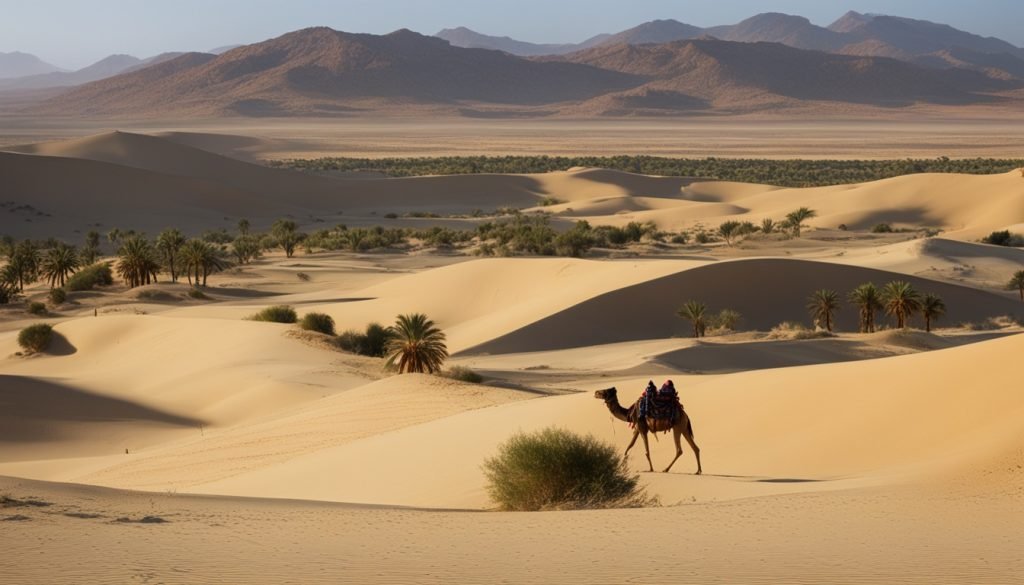
Major Geographic Features
Tunisia’s land is full of wonders, from beautiful beaches to the huge Sahara Desert. In the north, mountains are covered with green oak trees. The south has dry lands.
Climate Zones
The weather in Tunisia changes from place to place. The north has mild winters and hot summers.
As you go south, it gets drier and then turns into a desert. Here, it hardly rains and gets very hot.
Flora and Fauna
Tunisia’s animals and plants are very special. In the mountains, there are forests with big, tall trees.
The middle lands grow a tough type of grass. The deserts have plants and animals that can live without much water.
| Region | Climate | Flora | Fauna |
|---|---|---|---|
| North | Mediterranean | Cork Oak Forests | Wild Boar, Jackal |
| Central Steppes | Semi-Arid | Esparto Grass | Gazelles, Lizards |
| South | Desert | Desert Shrubs | Fennec Fox, Desert Hedgehog |
The Role of Tunisia in African and Global Organisations
Tunisia plays a big role in many groups. This shows it’s strong and active worldwide. It works with others for better global relationships.
Membership in African Union
Tunisia is important in the African Union. It helps shape Africa’s future. It works on peace, growth, and stability.
Tunisia joins meetings and projects in the Union. It helps make policies for Africa’s good.
Participation in International Organisations
Tunisia is also active in global organisations like the United Nations. It joins others to solve big world problems. This includes issues like climate change and humans rights.
Being part of these groups shows Tunisia’s big commitment. It wants to help the world in meaningful ways.
Tunisia’s Relationship with Africa
Tunisia is playing a big role in Africa. It is making its connections stronger in many ways. Let’s look at how Tunisia works with other African countries.
Economic Ties with African Countries
Tunisia has made important economic partnerships with many African countries. It focuses on trade agreements and investments together. By joining trade groups like the African Continental Free Trade Agreement (AfCFTA), Tunisia has grown its economic role.
This cooperation helps increase trade. It also creates a space for economies to grow together.
Cultural Exchange and Influence
Tunisia values sharing cultures with its African friends. It uses art, music, education, and sports for this. Events like the Carthage Film Festival are important. They show off African talent.
Political Alliances and Collaborations
Tunisia is keen on making political friends in Africa. It is active in groups like the African Union and the Arab Maghreb Union. These groups help Tunisia work on regional security and political stability.
They also work on sustainable development. Plus, agreements with other countries strengthen Tunisia’s role in Africa.
Misconceptions About Tunisia’s Geographical Identity
Tunisia’s location often sparks debate. This leads to many misconceptions about its identity. Even though it’s in North Africa, some think it’s mainly European because of its historical ties.
Many think of Tunisia as European because of its past. It connected with places like the Roman Empire and France. But it’s truly an African nation, deeply rooted in Africa.
Tunisia is also seen differently because of its economy and politics. It belongs to the African Union and other international groups. It’s vital in African politics. Yet, its economic links to Europe, like France and Italy, confuse some about its real roots.
Tunisia’s place in the Maghreb in North Africa shows it’s truly African. Features like the Sahara and the Atlas Mountains prove its African identity.
To clear up the confusion, we must learn about Tunisia. We should see it as an African country with a rich history and culture. Let’s celebrate Tunisia’s diverse heritage and its role in Africa.
Conclusion
We’ve learned a lot about Tunisia, a country in North Africa. It is near the Mediterranean Sea, Algeria, and Libya. This location makes Tunisia a meeting point between Africa and Europe. Its lands have coasts and deserts, showing its mixed nature.
Tunisia has a long history that interests many. It was home to ancient Carthage and has seen many rulers. Its culture mixes Arabic and French influences. This makes Tunisia truly special. Most people follow the Sunni Muslim faith, but other religions are also present.
Tunisia plays a big part in African and worldwide groups. It has strong ties in politics, economy, and culture. Some people misunderstand Tunisia’s place in the world. But, looking closely shows its true African roots and open view to the world. Tunisia is a place of old traditions and new ideas, deeply proud of its African roots and its global role.

